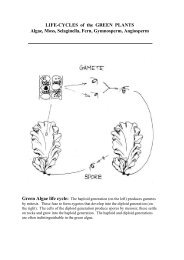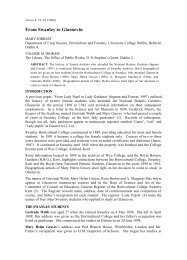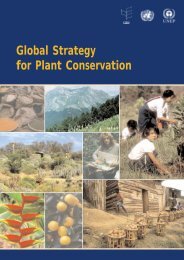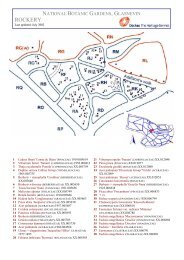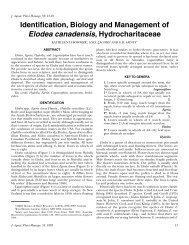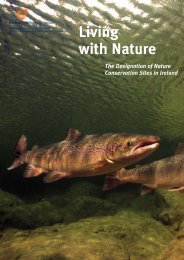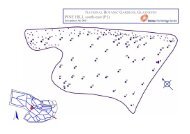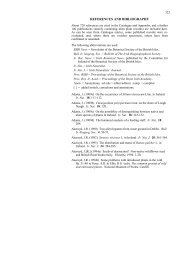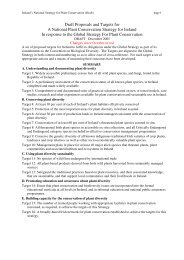A botanist in Ireland during World War II - National Botanic Gardens
A botanist in Ireland during World War II - National Botanic Gardens
A botanist in Ireland during World War II - National Botanic Gardens
Create successful ePaper yourself
Turn your PDF publications into a flip-book with our unique Google optimized e-Paper software.
Glasra 4: 103 – 106 (2008)<br />
A <strong>botanist</strong> <strong>in</strong> <strong>Ireland</strong> dur<strong>in</strong>g <strong>World</strong> <strong>War</strong> <strong>II</strong><br />
P.A. REILLY<br />
26 Neph<strong>in</strong> Road, Dubl<strong>in</strong> 7, Republic of <strong>Ireland</strong><br />
ABSTRACT: On 29 January 1941, Charles Faris of Farr<strong>in</strong>seer, Co. Cavan, wrote to Mrs N. Chambré<br />
of Dungannon, Co. Tyrone about his war-time botanical activities, travel difficulties due to a petrol<br />
shortage and his solutions, a field trip with Robert Lloyd Praeger and the keep<strong>in</strong>g and shar<strong>in</strong>g of his<br />
extensive records – now lost or mislaid. The letter came <strong>in</strong>to the possession of the late Doreen Lambert<br />
of Londonderry and was discovered amongst her papers by Ian McNeill of Cookstown, County Tyrone,<br />
who sent it to the author. It is now lodged <strong>in</strong> the archives of the <strong>National</strong> <strong>Botanic</strong> <strong>Gardens</strong>, Glasnev<strong>in</strong>,<br />
Dubl<strong>in</strong>.<br />
BACKGROUND TO THE FARIS LETTER<br />
The letter was written dur<strong>in</strong>g the second year of the 1939-1945 <strong>World</strong> <strong>War</strong>. Charles Faris lived<br />
<strong>in</strong> the Republic of <strong>Ireland</strong>, a neutral state, separated by a land border from Northern <strong>Ireland</strong>. Mrs<br />
Chambré resided <strong>in</strong> Northern <strong>Ireland</strong>, which, as part of the United K<strong>in</strong>gdom was embroiled <strong>in</strong><br />
the conflict. At this time, the war had reached a critical stage and the outcome was uncerta<strong>in</strong>. It<br />
is remembered for the bomb<strong>in</strong>g Blitz of cities <strong>in</strong> ma<strong>in</strong>land Brita<strong>in</strong>, the threat of <strong>in</strong>vasion from<br />
German-occupied France and submar<strong>in</strong>e attacks <strong>in</strong> the Atlantic on convoys of food, oil and other<br />
essential goods (Churchill, 1950). In January 1941, German bombs fell on Dubl<strong>in</strong>, and Belfast<br />
was bombed twice <strong>in</strong> April 1941 (Irish Times 1941). Botanists on both sides of the border<br />
communicated by post and met at organized field trips. The letter shows a remarkable degree of<br />
detachment by all parties from the cataclysmic events tak<strong>in</strong>g place nearby, a dedicated <strong>in</strong>terest <strong>in</strong><br />
field botany and an appreciation of its <strong>in</strong>tr<strong>in</strong>sic value.<br />
Charles Faris had a legal practice <strong>in</strong> Co. Cavan. He spent his spare time explor<strong>in</strong>g the countryside<br />
with Jean Cole of Cloverhill Co, Cavan, who later became his wife. They were associates<br />
of the em<strong>in</strong>ent Irish <strong>botanist</strong>, Robert Lloyd Praeger and contributed to supplements of his Irish<br />
Topographical Botany (1901), (Praeger, 1939 and 1946). They also published articles <strong>in</strong> the<br />
Irish Naturalist and the Irish Naturalists' Journal on the botany of Cavan, notably on rare ferns<br />
they discovered at Bruse Hill. They were highly regarded by Praeger who wrote that they<br />
‘added considerably to our knowledge of the distribution of flower<strong>in</strong>g plants’ and that Charles<br />
Faris ‘was a valued observer <strong>in</strong> a region <strong>in</strong> which naturalists are and have been few’ (Praeger,<br />
1949).<br />
In his letter, Faris refers to extensive field notes he made dur<strong>in</strong>g 1932–1940, cover<strong>in</strong>g the Cybele<br />
Hibernica (Moore & More, 1866) botanical district number 10, which <strong>in</strong>cluded counties Cavan,<br />
Monaghan, Fermanagh, Tyrone and Armagh. Mrs Chambré had evidently requested a copy,<br />
because <strong>in</strong> the letter he mentions that the notes were ‘very bulky, about 1000 pages …’.<br />
Members of the Cole and Faris families have no knowledge of the whereabouts of these notes or<br />
of copies he may have made.<br />
In addition to his botanical contributions, Charles Faris was a dist<strong>in</strong>guished entomologist, add<strong>in</strong>g<br />
two species of dragonfly to the Irish list (Faris, 1943; Faris and O’Rourke, 1946). He donated<br />
his collection of Irish <strong>in</strong>sects to the Royal Scottish Museum, Ed<strong>in</strong>burgh, because at the time, the<br />
Irish <strong>National</strong> Museum did not have an entomologist on its staff. The Royal Scottish Museum<br />
later transferred duplicates of Faris’ sawfly collection to the <strong>National</strong> Museum of <strong>Ireland</strong><br />
(O’Connor 1989). Charles Faris died <strong>in</strong> 1984. Jean, his widow, went to live <strong>in</strong> Scotland with<br />
her daughter, Mrs Jennifer Milliken. She died <strong>in</strong> 1999 and was buried beside her husband at<br />
Kilmore, Co. Cavan.
104 P. A. Reilly<br />
TEXT OF CHARLES FARIS’S LETTER TO MRS. N. CHAMBRÉ<br />
Farr<strong>in</strong>seer<br />
Cornafean<br />
Co. Cavan<br />
29.1.’41<br />
Dear Mrs. Chambré,<br />
We¹ were very glad to see by your letter that you are all well, and work<strong>in</strong>g hard. I<br />
saw <strong>in</strong> a recent I.N.J. 2 that you were collect<strong>in</strong>g Fairy Tales 3 , and feared that you<br />
were lost to the Naturalists !.<br />
Parsley Fern. I was on Bruse Hill 4 on Christmas Eve, but the grave of all our<br />
hopes has failed to produce any promise of a re<strong>in</strong>carnation, alas. We shall have to try<br />
to f<strong>in</strong>d another, I fear.<br />
Camel<strong>in</strong>a & Erysimum. Yes, there was a temporary confusion, the history of<br />
which is this. We were ahead and found one stray plant, new to us and brought it back<br />
to Dr Praeger, wonder<strong>in</strong>g if it could be a new sp. of Diplotaxus. He said “Now, what<br />
is that: it must be Camel<strong>in</strong>a sativa, but I have not seen it for years”. You said “Oh,<br />
Gold of Pleasure”. (I began to wonder where either of you had heard of such th<strong>in</strong>gs!!).<br />
Then Dr P. said “It must be Erysimum cheiranthoides”. Further along we came on a<br />
good plot of it & he confirmed his conjecture – we looked it up <strong>in</strong> Bentham & Hooker 5<br />
at once to fix it <strong>in</strong> our m<strong>in</strong>ds. All this, by the way, did happen at Drumhawanagh<br />
Station 6 Camel<strong>in</strong>a we have not yet seen.<br />
Cavan flora. Last Autumn I f<strong>in</strong>ish a 2 yr. task of go<strong>in</strong>g thro’ my Field Notes<br />
s<strong>in</strong>ce 1932 (as I write this Mr De Valera 7 is announc<strong>in</strong>g that Private Car owners are to<br />
get no petrol at all, henceforth!!!!!). Those notes <strong>in</strong>cluded all plant records for Miss<br />
Cole & myself to end of ’39 & all ’40, subject to conformation of a few new Co.<br />
records, specimens accompany<strong>in</strong>g the notes. We left them with Dr. Praeger last<br />
autumn, but have not heard from him s<strong>in</strong>ce.<br />
Even when we do hear from him and have the notes returned, they would be very<br />
bulky to transmit to you – about 1000 pages on paper the same size as this sheet<br />
[20.5mm x 25mm] mostly blank, of course!<br />
In any event, I do not th<strong>in</strong>k that the Censor<strong>in</strong>g Authorities [favour?] the send<strong>in</strong>g<br />
to and fro of lists of detailed localities. Miss Cole has a marked list of all plants<br />
recorded <strong>in</strong> each of the 5 counties (CV, MO, FE, TY, AR) 8 constitut<strong>in</strong>g the<br />
‘’Dist[trict] X’’ of Cybele 9 save the ’40 plants. Would it do if she marked up a copy<br />
of the CV portion for you? My copy is battered and is marked up to show the authority<br />
(i.e. place of publication) of every plant claimed for Dist X and I hesitate to risk it <strong>in</strong><br />
the post <strong>in</strong> these unsettled times, as I well remember the weeks of work go<strong>in</strong>g thro’<br />
paper after paper trac<strong>in</strong>g the records. Let me know if you would like this list and I shall<br />
hunt up a copy of the Museum hand list 10. Miss Cole will tick of the Cavan plants.<br />
Fail<strong>in</strong>g that, what about com<strong>in</strong>g down and see the full lists when returned from Dr.<br />
Praeger?<br />
We have not seen the ‘’Populus Solitude’’ 11 (as I th<strong>in</strong>k he should have called it)<br />
but it is good to know that you f<strong>in</strong>d it so very fasc<strong>in</strong>at<strong>in</strong>g.<br />
I am very glad that you are still collect<strong>in</strong>g records of the Tyrone plants, and hope<br />
you had a successful season <strong>in</strong> 1940. So much work has been po<strong>in</strong>tless because the<br />
workers would not go to the trouble of catalogu<strong>in</strong>g their results. At the moment there is
A BOTANIST IN IRELAND DURING WORLD WAR <strong>II</strong> 105<br />
every reason why these th<strong>in</strong>gs should be collected, copied, deposited <strong>in</strong> different places<br />
etc as it is impossible to conjecture what form of record will survive this war.<br />
Thursday morn<strong>in</strong>g<br />
Cavan still possesses the second smallest flora of all the 40 counties and vice<br />
counties, Monaghan be<strong>in</strong>g the only county possess<strong>in</strong>g fewer recorded plants. There is<br />
little hope of Monaghan los<strong>in</strong>g its booby prize, as its area is so small, its surface so<br />
unvaried and its mounta<strong>in</strong>s nonexistent.<br />
This petrol bus<strong>in</strong>ess will affect everyth<strong>in</strong>g. How on earth are we to get to [law]<br />
courts I do not know? I shall get to Cavan only from Tuesday morn<strong>in</strong>g till Thursday<br />
afternoon, do<strong>in</strong>g the sub-offices on Friday and Monday by bicycle from Farr<strong>in</strong>seer.<br />
S<strong>in</strong>ce the restriction of a month ago I have been almost permanently <strong>in</strong> Cavan. Many a<br />
good man has lost his life while br<strong>in</strong>g<strong>in</strong>g <strong>in</strong> petrol so we have noth<strong>in</strong>g to squeal about.<br />
I have just now opened negotiations for the purchase of a boat here (Belturbet 12 , where<br />
I am complet<strong>in</strong>g this letter) as it offers one way of gett<strong>in</strong>g about without petrol, and<br />
Lough Oughter, 13 Killykeen 14 and all those lovely spots are still largely unexplored –<br />
tho’ I do not expect to add more than 2 plants to the CV list from that area.<br />
Let me know if the ticked-off list will fulfil your requirements, and Miss Cole<br />
will get busy. If you want someth<strong>in</strong>g more elaborate we can arrange an ‘’<strong>in</strong>spection’’<br />
of the fuller list when it is returned.<br />
But, remember; if you want an answer to your next letter do NOT enclose stamps<br />
!!! Promise? Thank you.<br />
With best wishes to Mr Chambré and yourself from us both, and hop<strong>in</strong>g all<br />
the family are well.<br />
Yours s<strong>in</strong>cerely<br />
R. C. Faris<br />
ACKNOWLEDGEMENTS<br />
I am very grateful to Ian McNeill who found the Faris letter and for send<strong>in</strong>g it to me. I thank the<br />
members of the Faris and Cole families who helped with my research; Mrs Doreen Lord of<br />
Crossdoney, Charles Faris’s sister; Mrs. Phyllis Faris of Cornafean, his sister-<strong>in</strong>-law and Mrs<br />
Susan McCauley of Cloverhill, his niece. I am especially <strong>in</strong>debted to Mrs Rosemary Coetzee and<br />
her sister Mrs. Jennifer Milliken, daughters of Charles and Jean Faris, for search<strong>in</strong>g the family<br />
archives, answer<strong>in</strong>g my queries and giv<strong>in</strong>g permission to publish the letter. My special thanks to<br />
Walter and Bríd Myles of Halcyon, Drumalee, Co. Cavan, who made the <strong>in</strong>itial <strong>in</strong>troductions<br />
and to Charles Nelson for read<strong>in</strong>g the article and for his helpful comments.<br />
NOTES<br />
1 ‘We’: Charles Faris and his fiancée, Jean Cole. They married <strong>in</strong> 1941.<br />
2 INJ: Irish Naturalists' Journal.<br />
3 INJ September, 7:360, 1940. ‘Collect<strong>in</strong>g fairy tales’ Review of Ulster Journal of<br />
Archaeology 3 rd series, Vol. 3: 1, January 1940 ‘ T.G.F. Paterson <strong>in</strong> collaboration with Mrs<br />
Chambré, contributed a number of fairy tales taken down from the lips of Peter M’ Mullan,<br />
of Candia, Co. Tyrone’.
106 P. A. Reilly<br />
4 Bruse Hill: Location, east of Arvagh at N 98-32: height 858 ft.<br />
5 Bentham and Hooker: ‘Handbook of the British Flora’ (1858).<br />
6 Drumhawnagh Station: Location, south of Bellananagh at N 3592. A local railway station<br />
now closed.<br />
7 Mr. De Valera: <strong>War</strong>-time Prime M<strong>in</strong>ister of the Irish Free State. It was declared the<br />
Republic of <strong>Ireland</strong> <strong>in</strong> 1948.<br />
8 CV, MO, FE, TY,AR: Counties Cavan, Monaghan, Fermanagh, Tyrone and Armagh.<br />
9 Cybele Hibernica (1866) by David Moore and Alexander Goodman More. In Cybele <strong>Ireland</strong><br />
was divided <strong>in</strong>to twelve districts to show plant distribution. Cavan is <strong>in</strong> district 10.<br />
10 Liosta de phlanndai na hEireann, Hand-list of Irish plants, published by the <strong>National</strong><br />
Museum of <strong>Ireland</strong> (Natural History Division) .The third edition was issued <strong>in</strong> 1934.<br />
11 A pun, referr<strong>in</strong>g to R.Ll. Praeger’s ‘A Populous Solitude’ (Dubl<strong>in</strong>: Hodges & Figgis 1941).<br />
12 Belturbet: Location, west of Redhills at H3616.<br />
13 Lough Oughter: The body of lakes that forms the bas<strong>in</strong> of the River Erne between<br />
Crossdoney (H 3700) and Bakers Bridge (H 3712).<br />
14 Killykeen (H 3405). Now a national park on Lough Oughter, classified as an area of<br />
scientific <strong>in</strong>terest of <strong>in</strong>ternational importance.<br />
REFERENCES<br />
Churchill, W<strong>in</strong>ston. S. 1950. The Second <strong>World</strong> <strong>War</strong>. vol. 3:38-39.<br />
Faris, R.C. 1943. A dragonfly new to <strong>Ireland</strong>, Sympetrum fonscolombii Selys. Irish Naturalists'<br />
Journal 8: 114.<br />
Faris, R.C. & O'Rourke, F.J. 1946. Orthetrum cancellatum L., a dragonfly new to <strong>Ireland</strong>, and<br />
other dragonfly notes from Connaught. Irish Naturalists' Journal 8: 387-390.<br />
Moore, D. & More A.G. 1866. Contributions towards a Cybele Hibernica. Hodges, Smith &<br />
Co., Dubl<strong>in</strong>.<br />
O’Connor, J.P. 1989. Richard Charles Faris [Obituary] Irish Naturalists' Journal 23: 37-38.<br />
Praeger, R.Ll. 1901. Irish Topographical Botany. Proceed<strong>in</strong>gs of the Royal Irish Academy<br />
(third series) 7: i-clxxxviii, 1-410.<br />
Praeger, R.Ll. 1939. A further contribution to the flora of <strong>Ireland</strong>. Proc. R. Ir. Acad. 45b: 231-<br />
254.<br />
Praeger, R.Ll. 1946. Additions to the knowledge of the Irish flora. Proc. R. Ir. Acad. 51b, 27-<br />
51.<br />
Praeger, R.Ll. 1949. Some Irish Naturalists. Dundalgan Press, Dundalk.



